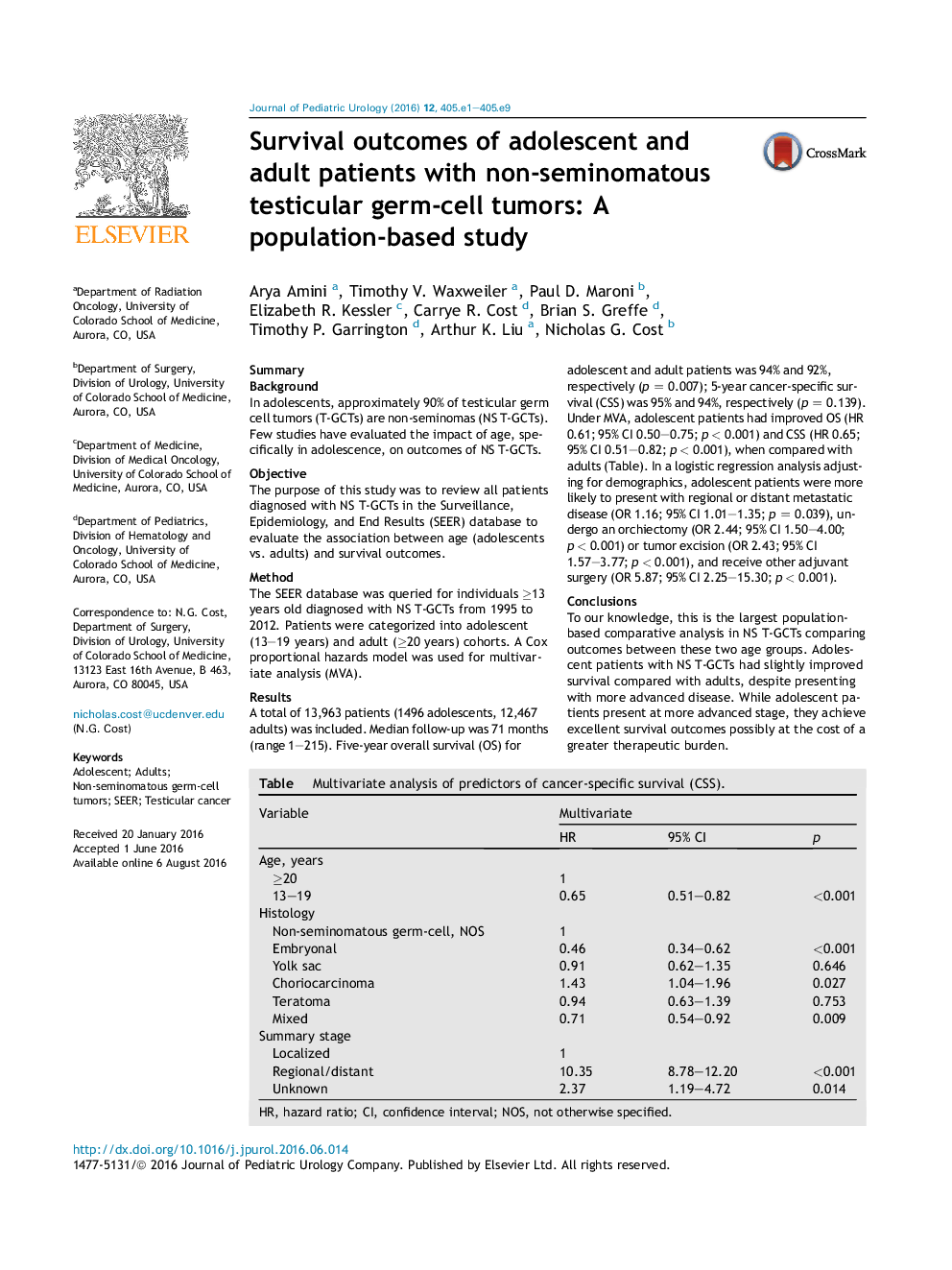| کد مقاله | کد نشریه | سال انتشار | مقاله انگلیسی | نسخه تمام متن |
|---|---|---|---|---|
| 5718729 | 1411256 | 2016 | 9 صفحه PDF | دانلود رایگان |
SummaryBackgroundIn adolescents, approximately 90% of testicular germ cell tumors (T-GCTs) are non-seminomas (NS T-GCTs). Few studies have evaluated the impact of age, specifically in adolescence, on outcomes of NS T-GCTs.ObjectiveThe purpose of this study was to review all patients diagnosed with NS T-GCTs in the Surveillance, Epidemiology, and End Results (SEER) database to evaluate the association between age (adolescents vs. adults) and survival outcomes.MethodThe SEER database was queried for individuals â¥13 years old diagnosed with NS T-GCTs from 1995 to 2012. Patients were categorized into adolescent (13-19 years) and adult (â¥20 years) cohorts. A Cox proportional hazards model was used for multivariate analysis (MVA).ResultsA total of 13,963 patients (1496 adolescents, 12,467 adults) was included. Median follow-up was 71 months (range 1-215). Five-year overall survival (OS) for adolescent and adult patients was 94% and 92%, respectively (p = 0.007); 5-year cancer-specific survival (CSS) was 95% and 94%, respectively (p = 0.139). Under MVA, adolescent patients had improved OS (HR 0.61; 95% CI 0.50-0.75; p < 0.001) and CSS (HR 0.65; 95% CI 0.51-0.82; p < 0.001), when compared with adults (Table). In a logistic regression analysis adjusting for demographics, adolescent patients were more likely to present with regional or distant metastatic disease (OR 1.16; 95% CI 1.01-1.35; p = 0.039), undergo an orchiectomy (OR 2.44; 95% CI 1.50-4.00; p < 0.001) or tumor excision (OR 2.43; 95% CI 1.57-3.77; p < 0.001), and receive other adjuvant surgery (OR 5.87; 95% CI 2.25-15.30; p < 0.001).ConclusionsTo our knowledge, this is the largest population-based comparative analysis in NS T-GCTs comparing outcomes between these two age groups. Adolescent patients with NS T-GCTs had slightly improved survival compared with adults, despite presenting with more advanced disease. While adolescent patients present at more advanced stage, they achieve excellent survival outcomes possibly at the cost of a greater therapeutic burden.Table. Multivariate analysis of predictors of cancer-specific survival (CSS).VariableMultivariateHR95% CIpAge, years â¥201 13-190.650.51-0.82<0.001Histology Non-seminomatous germ-cell, NOS1 Embryonal0.460.34-0.62<0.001 Yolk sac0.910.62-1.350.646 Choriocarcinoma1.431.04-1.960.027 Teratoma0.940.63-1.390.753 Mixed0.710.54-0.920.009Summary stage Localized1 Regional/distant10.358.78-12.20<0.001 Unknown2.371.19-4.720.014HR, hazard ratio; CI, confidence interval; NOS, not otherwise specified.
Journal: Journal of Pediatric Urology - Volume 12, Issue 6, December 2016, Pages 405.e1-405.e9
